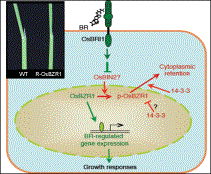Research in Prof. Zhiyong Wang's group found that OsBZR1 and 14-3-3 protein play an important role in BR signaling in rice. Suppressing OsBZR1 expression by RNA interference (RNAi) resulted in dwarfism, erect leaves, reduced BR sensitivity, and altered BR-responsive gene expression in transgenic rice plants. 14-3-3 proteins are phosphopeptide-binding proteins that are highly conserved in all eukaryotes. 14-3-3 proteins can interact with OsBZR1 in yeast and plant cells and were repressed by BR treatment. 14-3-3 protein binding to OsBZR1 inhibits OsBZR1 function at least in part by reducing its nuclear localization ( PNAS, 2007 ) .

Figure . A model of the BR signal transduction pathway in rice. BRs bind to the receptor kinase OsBRI1 on the cell surface to activate the signal transduction pathway that leads to dephosphorylation and activation of transcription factor OsBZR1. When the BR levels are low, OsBZR1 is phosphorylated, likely by the rice homolog of BIN2 kinase, and retains in the cytoplasm by the 14-3-3 proteins. BR-induced dephosphorylation of OsBZR1 abolishes interaction with 14-3-3s, allowing OsBZR1 to move into the nucleus to regulate BR-responsive genes expression.
